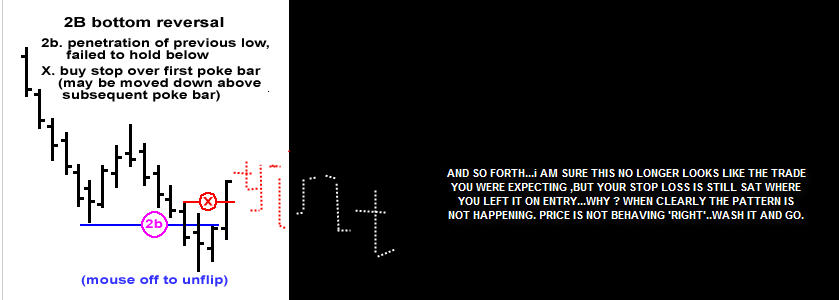Perhaps - considering the fact that dbphoenix first stated he wouldn't take that signal in the first place - it is conceivable that - assuming you are to take a trade based on a pattern of which you aren't entirely convinced it has a high enough chance of succeeding - you will want to see it move in the right direction immediately.
On other occassions, (different pattern, different situation, different price action), where you see a trade that has a high probability of succes, you won't exit on the account that the first couple of bars/candles/... don't exhibit the behaviour you are expecting to develop, but instead you hold on and see what hand the market deals you.
From that perspective, decisions are made based on the market dynamics, but also taking into account the context of the decision. Having said that, this would mean it is perfectly okay to on one occasion exit rather quickly after the entry if it does not do what you expect it, and on another occasion hold on a bit longer. Context, price, dynamics... am I making sense?
Absolutely, that makes perfect sense.
Although my example was just intended as an example, never minding if one liked it or not, ie it was just intended as an example to let DB explain his point which I feel just isn't coming across by demonstrating with a picture, always the best way to explain stuff.

Eg I think I'm explaining clearly enough what I'm doing.
Not saying at all that that is the only way or even the best way, but at least people can follow what I'm on about.
I trade my setups the same old way over and over, I go in and say I have no clue what will happen next, I'll just let price show me, while giving price rope to breathe.
For me a setup like the 2B is valid until price shows me I'm wrong by invalidating the setup.
If you're trading moving averages crossovers you've backtested a long signal is only invalidated until the MA's cross back over again.
Again, MA's just by way of explaining my point.
I'm out with a loss only if the setup is invalidated.
If price goes my way, I try and pull my SL up to breakeven as quickly as possible.
And, once that happens, I just trail my profits.
In other words, I just always let the market show me what's happening, I never anticipate whats going to happen or cut a trade short arbitrarily when there is nothing to warrant that.
I just try and hang on as long as the trend is going my way, fully accepting that a trend is not a straight up development, it's ensuing higher highs and higher lows, meaning if I want to maximise my gains, I need to be able to sit through retracements.
To be honest, I do not believe it is possible to catch every swing in the market, for the simple reason that I believe anything can happen in markets at any time, all it takes is one massive order to totally change the technical picture.
My example of the 2B was just an example to let DB show us his trade management to explain the point he is making about stops being nonsense, but I just really do not understand at all where there is anything even remotely resembling a reason to exit the trade here where he says he'll be out:
Okay, example:
Assuming entry at "X", I'd be out.
Particularly in view of this statement:
And as for maximizing profits, I seem to be in trades far longer than most people since I'm not frightened out by every little twist and turn.
I suspect what we have here is a more fundamental difference seated in the style of trading we prefer..that is more discretionary as opposed to more mechanical and that is really just a personality thing about which there is no universal right or wrong.
Chumps Pic:
Chump, I do get your point.
But, and that is where styles really do differ, to me that's still a viable signal, on the grounds that to me trading is at the end of the day just a probability game, it is just a numbers game, not a game of predicting what will happen next, which in essence one is doing by exiting when it's not going straight up.
Just because it isn't going straight up
right away isn't to say that it won't at all, which would offer me a great trade.
Catching every single swing just isn't feasible I think, all that leads to is churning up your execution costs while jumping in and out too much.
But then, different horses fro different courses.
;-)


